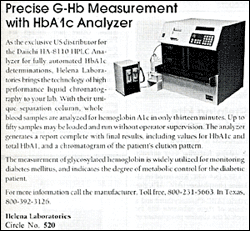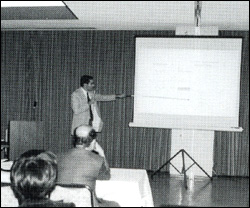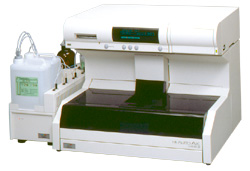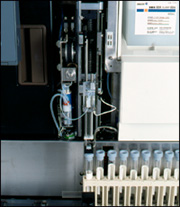Color Trading Sp. z o. o. Asia-Pacific site
- English
Please select your Region.
Please select your Region.

HA-8110 appeared in overseas journal
Today people know that HbA1c is highly important for diabetes study, however, in the 1970s, when HA-8110 was being developed, nobody knew about HbA1c in Japan, except some research pioneers. The measurement method itself was not general so that HbA1c was not applied in clinical settings. Only some researchers were studying the glycation of blood hemoglobin (binding of hemoglobin and sugars or its metabolites in blood) of the diabetics. There were not many literatures about HbA1c, and none in Japanese. Some was performing the measurement of HbA1c using mini column method in the U.S.A. Other than that, it was not too much to say nobody knew what HbA1c was and what it was for.
Under the circumstances, practical application of the measurement of HbA1c achieved by HA-8110 created a sensation all over the world as well as in Japan.
The usability of HbA1c in diabetes screening and as patients' control indicator was obvious, but HbA1c measurement by HPLC method was not covered by insurance in those days. (HbA1 was covered by insurance.)

The First Vensonic Seminar (1983)
ARKRAY talked to academic societies and succeeded in organizing a study group about HbA1c with doctors noted for their diabetes study. For discussing the study outcomes, we held VENSONIC seminars all over in Japan. VENSONIC is a combination term of "venture" and "sonic." It was made by a leading authority on diabetes, Dr. Shigeaki Baba, Kobe University that time, with the hope that ARKRAY's venture spirit and new knowledge would spread further. VENSONIC seminar invited leading A1c researchers from abroad and became highly recognized as ARKRAY's study support activity.
After this, the success of this kind of research was recognised and it became covered by medical insurance. Hbf (Hemoglobin F), which was not believed to exist in adults, was then recognised using this method and came to be used as part of the HPLC method.
We saw diabetes in proper perspective and continued our study firmly believing that HbA1c was necessary for diabetes testing. This made basis of today's diabetes testing and it is still our pride.
In 1994, about 13 years after the development of HA-8110, the third generation of the HA series, HA-8130 was released.

HA-8131(1994)
The greatest feature of HA-8130 is the Cap-Piercing mechanism, where blood sample is drawn into the system without removing a cap of a vacuum blood collection tube. Before Cap-Piercing, blood drawing was performed in a troublesome and dangerous way; a cap of each vacuum blood collection tube was removed before drawing blood sample and it was put back on after drawing. The Cap-Piercing method not only reduced workload of opening and closing caps but also helped to protect lab technicians from possible infections.
We faced difficulties in the development of the Cap-Piercing mechanism. After an injection needle sticks a cap of a vacuum blood collection tube several times, the needle tip gets worn and dull, and the needle can no longer stick a cap. Since HA-8131 blood sampling needle sticks tens of thousands of caps annually, we needed to come up with an idea of a needle which would not get dull even in frequent sticking. We came up with an idea: traditional phonograph needle. A phonograph needle traces record grooves, which are like sandpaper, at high speed, but the needle does not become worn easily. This is because the needle tip is made from the substance with high degrees of hardness such as diamond or sapphire. In addition, the diameter of a phonograph needle tip is 0.5mil (about 0.012mm) and that is adequate tip for sticking the rubber cap of a vacuum blood collection tube.
We talked about the idea to a jewelry maker, who handled diamond and sapphire, and got a response that sapphire could be set on the tip of the injection needle. We made a prototype needle with sapphire and performed a durability test. The result showed that the sapphire-tipped needle remained sharp after more than 100,000 sticks. This is how the piercing needle, an essential item for the Cap-Piercing method, was developed.

Cap-Piercing method
(adopted to HA-8160)
HA series was developed in cooperation with the major general chemical maker, and was evolved furthermore with the collaboration from a jewelry maker, who has no relation with clinical test. Now HA series has become a product with no equal. HA series went through improvements and they are widely used as a flagship model in the A1c measurement even today. We believe that the performance of HA series reflects the fact that we took all the available means, continued challenging, and did not give up on the development of better instrument.
![]()